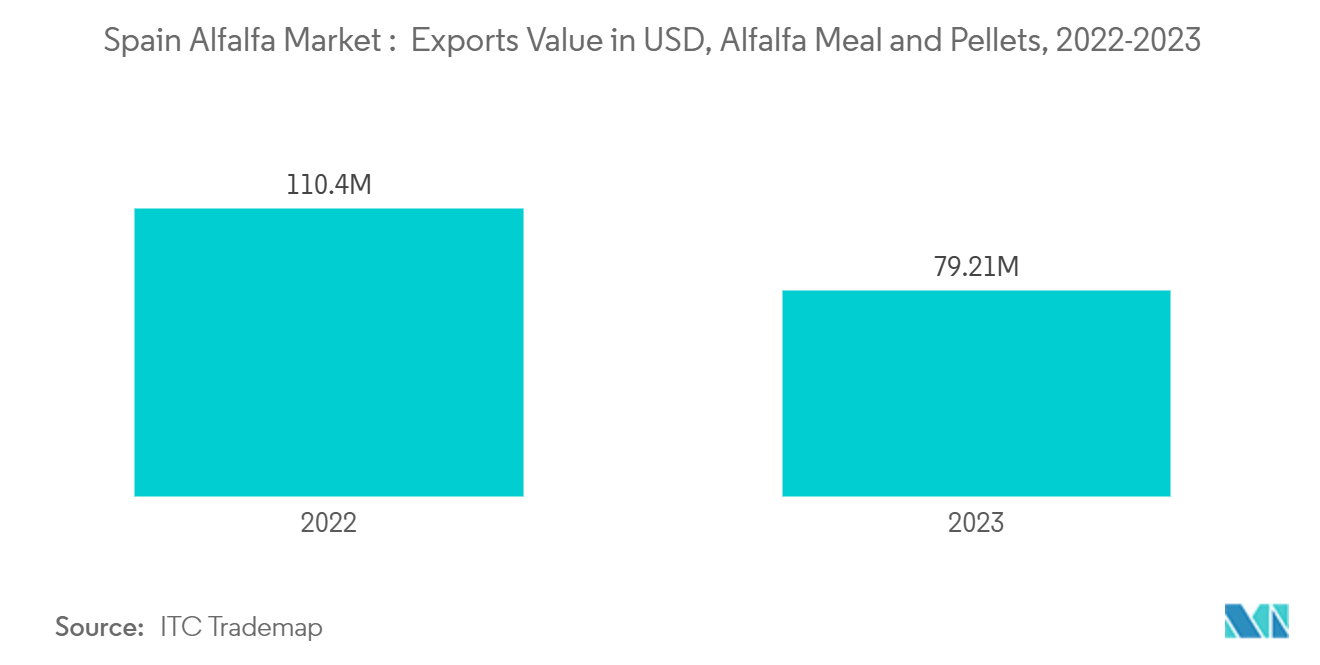Market Trends of Spain Alfalfa Hay Industry
Alfalfa Exports Face Decline in 2022 and 2023
- Saudi Arabia, the United Arab Emirates, Jordan, and Lebanon lead the charge in the Middle East's expanding export scene. At the same time, Asian markets, with a spotlight on Japan and Korea, are unearthing new export avenues. However, with global competition heating up, navigating the intricacies of Asian trade routes has become increasingly challenging.
- Data from the International Trade Center reveals that in 2023, Spain's alfalfa exports were valued at USD 79.2 Million, representing a significant 28% drop from 2022. The 2023 year's exports were limited due to dry conditions affecting both production and export volumes. While 2024 shows promise for a rebound in exports, intensified competition from global suppliers could pose challenges, potentially preventing Spain’s exports from fully recovering to pre-MY 2023/24 levels.
- According to estimates from the United States Department of Agriculture, Spain's fodder production and exports, including Alfalfa Hay, are set to rebound in MY 2024/25. An anticipated increase in both cultivated areas and yields is expected to bring fodder production back to its average levels. With this resurgence, exports are forecasted to jump to 1 million metric tons in MY 2024/25, up from 600 thousand metric tons in MY 2023/24.

Meat/Dairy Animal Feed is the Leading Segment
- Primarily, alfalfa hay serves as animal feed, catering to dairy cows, horses, beef cattle, sheep, chickens, and turkeys. Notably, dairy and beef cattle emerge as the predominant consumers of alfalfa in the nation. Renowned for its superior protein content, alfalfa hay is linked to enhanced animal productivity. Among various fodders, alfalfa hay is deemed optimal, largely due to its widespread availability. Uniquely, it's the sole forage produced and marketed across all states.
- The Fresh and Frozen Beef exports are poised to drive the demand for alfalfa hay. Spain's bovine sector holds significant economic weight, accounting for approximately 30% of the nation's total livestock production. A significant portion of the country's beef supply caters to the Hotel, Restaurant, and Institutional (HRI) sector, which saw robust demand in 2022, buoyed by a resurgence in tourism to pre-pandemic levels. Due to the HRI sector, beef consumption in Spain had been on the rise in 2022 and 2023. Spanish fresh beef exports, valued at USD 1 billion in 2023, continued to flourish in both EU and non-EU markets. Notably, outside the EU, key markets for frozen Spanish beef include Canada, the United Kingdom, the Philippines, and Japan.
- On December 30, 2022, Spain enacted national legislation to oversee its beef and dairy cattle sectors. This legislation establishes foundational rules for cattle farms. While some provisions are already in effect, others will be phased in over time. Key objectives include harmonizing and enhancing hygiene and biosecurity measures, adapting to the sector's evolution and societal changes, and addressing emerging challenges in animal welfare, environmental concerns, and animal health. These legislative efforts aimed at bolstering the cattle population are expected to positively influence the alfalfa market.


